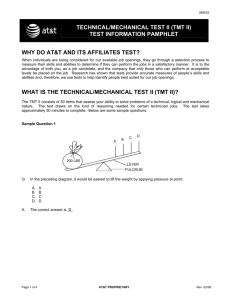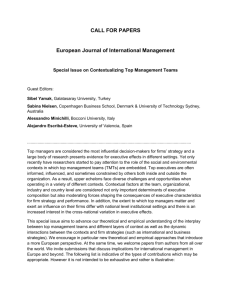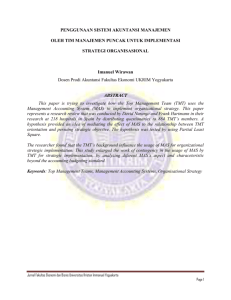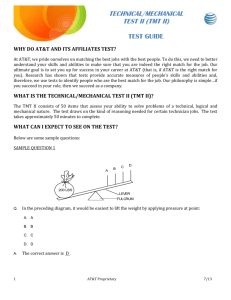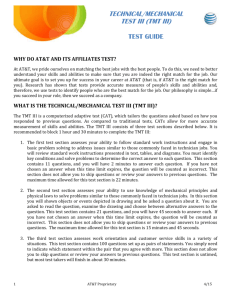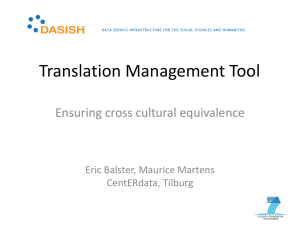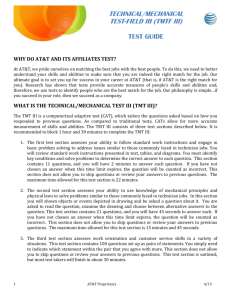1 MB
advertisement
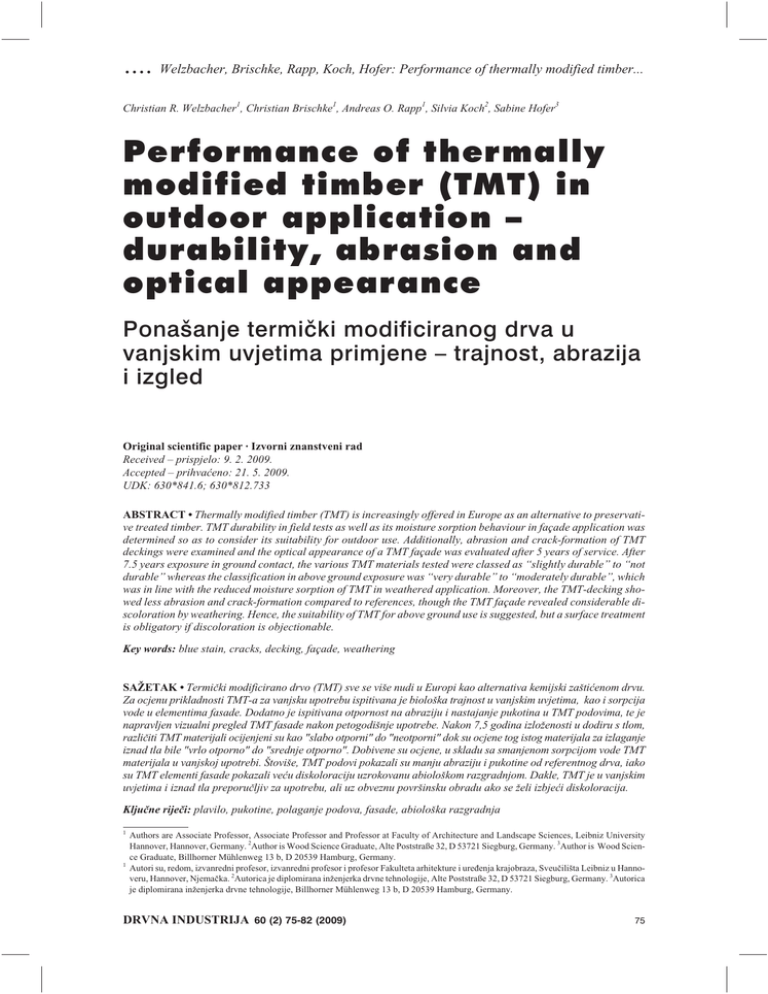
.... Welzbacher, Brischke, Rapp, Koch, Hofer: Performance of thermally modified timber...
Christian R. Welzbacher1, Christian Brischke1, Andreas O. Rapp1, Silvia Koch2, Sabine Hofer3
Performance of thermally
modified timber (TMT) in
outdoor application –
durability, abrasion and
optical appearance
Pona{anje termi~ki modificiranog drva u
vanjskim uvjetima primjene – trajnost, abrazija
i izgled
Original scientific paper · Izvorni znanstveni rad
Received – prispjelo: 9. 2. 2009.
Accepted – prihva}eno: 21. 5. 2009.
UDK: 630*841.6; 630*812.733
ABSTRACT • Thermally modified timber (TMT) is increasingly offered in Europe as an alternative to preservative treated timber. TMT durability in field tests as well as its moisture sorption behaviour in façade application was
determined so as to consider its suitability for outdoor use. Additionally, abrasion and crack-formation of TMT
deckings were examined and the optical appearance of a TMT façade was evaluated after 5 years of service. After
7.5 years exposure in ground contact, the various TMT materials tested were classed as “slightly durable” to “not
durable” whereas the classification in above ground exposure was “very durable” to “moderately durable”, which
was in line with the reduced moisture sorption of TMT in weathered application. Moreover, the TMT-decking showed less abrasion and crack-formation compared to references, though the TMT façade revealed considerable discoloration by weathering. Hence, the suitability of TMT for above ground use is suggested, but a surface treatment
is obligatory if discoloration is objectionable.
Key words: blue stain, cracks, decking, façade, weathering
SA@ETAK • Termi~ki modificirano drvo (TMT) sve se vi{e nudi u Europi kao alternativa kemijski za{ti}enom drvu.
Za ocjenu prikladnosti TMT-a za vanjsku upotrebu ispitivana je biolo{ka trajnost u vanjskim uvjetima, kao i sorpcija
vode u elementima fasade. Dodatno je ispitivana otpornost na abraziju i nastajanje pukotina u TMT podovima, te je
napravljen vizualni pregled TMT fasade nakon petogodi{nje upotrebe. Nakon 7,5 godina izlo`enosti u dodiru s tlom,
razli~iti TMT materijali ocijenjeni su kao "slabo otporni" do "neotporni" dok su ocjene tog istog materijala za izlaganje
iznad tla bile "vrlo otporno" do "srednje otporno". Dobivene su ocjene, u skladu sa smanjenom sorpcijom vode TMT
materijala u vanjskoj upotrebi. [tovi{e, TMT podovi pokazali su manju abraziju i pukotine od referentnog drva, iako
su TMT elementi fasade pokazali ve}u diskoloraciju uzrokovanu abiolo{kom razgradnjom. Dakle, TMT je u vanjskim
uvjetima i iznad tla preporu~ljiv za upotrebu, ali uz obveznu povr{insku obradu ako se `eli izbje}i diskoloracija.
Klju~ne rije~i: plavilo, pukotine, polaganje podova, fasade, abiolo{ka razgradnja
1
1
Authors are Associate Professor, Associate Professor and Professor at Faculty of Architecture and Landscape Sciences, Leibniz University
Hannover, Hannover, Germany. 2Author is Wood Science Graduate, Alte Poststraße 32, D 53721 Siegburg, Germany. 3Author is Wood Science Graduate, Billhorner Mühlenweg 13 b, D 20539 Hamburg, Germany.
Autori su, redom, izvanredni profesor, izvanredni profesor i profesor Fakulteta arhitekture i ure|enja krajobraza, Sveu~ili{ta Leibniz u Hannoveru, Hannover, Njema~ka. 2Autorica je diplomirana in`enjerka drvne tehnologije, Alte Poststraße 32, D 53721 Siegburg, Germany. 3Autorica
je diplomirana in`enjerka drvne tehnologije, Billhorner Mühlenweg 13 b, D 20539 Hamburg, Germany.
DRVNA INDUSTRIJA 60 (2) 75-82 (2009)
75
Welzbacher, Brischke, Rapp, Koch, Hofer: Performance of thermally modified timber...
1 INTRODUCTION
1. UVOD
The ability of thermal modification processes to
improve the resistance of wooden products against fungal decay has been intensively investigated and promoted in recent years (Syrjänen and Kangas, 2000; Boonstra and Tjeerdsma, 2006; Del Menezzi and Tomaselli
2006). On account of the increased durability of thermally modified timber (TMT) compared to untreated
material, its application above ground in use class 3
(EN 335-1, 2006) has often been recommended (i.a.
Jämsä and Viitaniemi, 2001; Wienhaus, 1999). On the
other hand, the applicability of TMT for use in ground
contact (use class 4, EN 335-1, 2006) is still a matter of
controversial discussion, because TMT is frequently
classed as “very durable” to “durable” (durability class
1-2, EN 350-2, 1994) in laboratory tests (e.g. Boonstra
and Doelman, 1999; Tjeerdsma et al, 2000), which would in theory allow an application in soil contact (EN
460, 1994). Additionally, various industrial suppliers
promote their TMT products with unlimited suitability
for use in ground contact, which also emphasizes the
uncertainty of consumers.
However, besides typical applications in use class
3 like claddings and façades, TMT is mostly used for
horticultural products, e.g. wooden decks and floorings.
Concerning these non- or less-load bearing applications,
the resistance to abrasion becomes the decisive mechanical property of the material used, since numerous authors
referred to an increase in brittleness and occurrence of
splinters and flake offs compared to untreated wood (i.a.
Jämsä and Viitaniemi, 2001; Militz, 2000).
Alongside durability and mechanical properties,
the optical appearance of TMT in use is increasingly
spotlighted by consumers, because the brownish color
of uncoated TMT is non-stable against UV irradiation
(Sailer et al, 2000; Junghans and Niemz, 2005) and
TMT exhibits discoloration and staining in weathered
exposure.
This paper presents the results of field tests after
7.5-year exposure in use class 3 and 4, results regarding
the moisture sorption behaviour of TMT in façade ap-
....
plication as well as the outcome of abrasion tests and
visual observations regarding the optical performance
of a TMT-façade after 5 years in service in order to contribute to the discussion on the suitability of commercially available TMT for outdoor application.
2 MATERIALS AND METHODS
2. MATERIJALI I METODE
2.1 Moisture sorption behaviour of TMT
façade boards
2.1. Pona{anje TMT elemenata fasade s obzirom
na sorpciju vode
Determination of moisture behaviour in weathered application was performed with boards of
500x122x22 mm³ from European larch heartwood (Larix decidua Mill.), Scots pine sapwood (Pinus sylvestris L.), Norway spruce sapwood (Picea abies Karst.)
and Oil-Heat-treated spruce sapwood (220°C, 1h).
These materials (n=9) were mounted with stainless
screws as weather boarding on a house façade in East,
West and South orientation in Kiel, North-Germany, in
9 different locations in the year 2000 (Figure 1).
Polyamide coated stainless steel cables as electrodes were glued in the reverse side of the boards with
graphite containing glue mixtures according to
Brischke et al. (2008). The wood moisture content
(MC) was determined and recorded daily over a period
of one year (April 2000 to April 2001) by measuring the
electrical resistance, as described by Pöhlmann (2001).
In 2007, the boards were removed from the façade and were exposed freely suspended to natural weathering at Hamburg University in Hamburg-Lohbrügge
for a period of 4 months, from March 2007 to July
2007. The MC of specimens was measured gravimetrically during this exposure.
2.2 Durability tests
2.2. Testovi biolo{ke otpornosti
Field trials in soil contact and above ground were
installed in 2001 to examine the durability of the various TMT materials (Table 1) in differently severe exposure conditions.
Figure 1 East and South-West orientation of the house facade in Kiel; Arrows point to the location of TMT boards with glued-in electrodes for long-term moisture recording
Slika 1. Isto~no i jugozapadno pro~elje ku}e u Kielu: strelice pokazuju mjesta promatranih TMT
elemenata fasade s ugra|enim elektrodama za dugotrajno pra}enje sadr`aja vode u drvu
76
DRVNA INDUSTRIJA 60 (2) 75-82 (2009)
.... Welzbacher, Brischke, Rapp, Koch, Hofer: Performance of thermally modified timber...
Table 1 Abbreviations in tables and figures (Abbr.), corresponding to wood species, process description and supplier of the thermally modified material
Tablica 1. Kratice u tablicama i slikama koje odgovaraju vrsti drva, postupku modifikacije i dobavlja~u (proizvo|a~u) termi~ki
modificiranog drva
Abbreviation
Kratica
Wood species
Vrsta drva
Modification process
Postupak modifikacije
Supplier
Dobavlja~ (proizvo|a~)
Plato
Picea abies Karst.
PLATO process
Plato Hout B.V., Netherlands
Thermowood
Pinus sylvestris L.
Thermowood process
Kestopuu Oy, Finland
NOW
Pinus maritima Mill.
Retification process
S.A. NOW, France
OHT
Pinus sylvestris L.
Oil-Heat process*
Menz Holz, Germany
* Rapeseed oil-retention was minimized to less than 5 kg/m³ / Retencija repi~ina ulja svedena je na minimum (manje od 5 kg/m3).
The number of replicates was n=20 for each test
set-up, the dimension of the specimens was 500x50x25
mm³ (except NOW: 500x50x20 mm³). According to EN
252 (1990) the samples for field tests in ground contact
were planted in the field at the Federal Research Centre
for Forestry and Forest Products, Hamburg at a distance
of 30 cm to each other. The durability of the different
materials above ground in use class 3 (EN 335–1, 2006)
was tested using the double layer test method according
to Augusta and Rapp (2005), in which samples were
shifted by one sample half to create an artificial water
trap between both horizontal layers.
Decay on samples from field tests in use class 4
and 3 was determined yearly according to EN 252
(1990) using the five step rating scheme, which classifies depth and distribution of decay (0=sound, 1=slight
attack, 2=moderate attack, 3=severe attack, 4=failure).
These decay ratings were taken as basis to determine
the durability. According to EN 252 (1990) x-values
are used to calculate the durability based on the mean lifetime. Since the mean lifetime was not yet obtained for
all tested materials after 7.5 years, the durability was
calculated as the quotient of the decay rate of the controls and the decay rate of the material tested (durability
factor f), as shown in equation 1 and 2.
decay rate =
mean decay rating
time of exposure
durability factor f =
decay rate control
decay ratetested specimens
(1)
(2)
Decay types were determined according to DIN
CEN/TS 15083-2 (2005).
2.3 Abrasion tests
2.3. Testovi abrazije
For the abrasion tests, commercially heat treated
beech (Fagus sylvatica L., Thermowood, 230°C for 4h)
was applied besides beech controls and larch heartwood
(Larix decidua L.), which is a typical softwood species
for decking applications. Heat treated beech was used in
this study, since this mechanically strong and abrasion-resistant European hardwood species with improved durability and dimensional stability by the thermal
modification is increasingly used as decking material to
substitute tropical timber. Two tests were performed to
characterize the abrasion performance: the “Shaker” test
according to Brischke et al. (2006) and the Taber abraser
test according to DIN EN 438-2 (1992).
The resistance to abrasion after the Shaker-method was determined as follows: 5 specimens of
35x10x10 mm³ were oven dried, weighed and put into a
polyethylene flask of 0.5 l together with 400 g of steel
balls of 6 mm diameter (Figure 2). The filled flasks
were put in an overhead shaker and rotated with 28
min-1 for 72 hours. Afterwards, the specimens were cleansed of wood dust by air pressure, oven dried and weighed again to determine the abrasion in terms of mass
loss. Five specimens were weighed together and gave
one replicate, ten replicates were used.
The following modifications of the Taber abraser
test were made in order to allow testing of solid wood:
Specimens of 100x100x7 mm³ were prepared and conditioned in 20°C/65%RH. The tree rings of all specimens were oriented 45° to their cutting edges. After
weighing and measuring the thickness at 4 points, the
specimens (n=10) were clamped into the Taber abraser
Figure 2 Polyethylene flask, steel balls, specimens and over-head shaker used in Shaker-tests
Slika 2. Polietilenske bo~ice, ~eli~ne kuglice, uzorci i ure|aj za ispitivanje abrazije
DRVNA INDUSTRIJA 60 (2) 75-82 (2009)
77
Welzbacher, Brischke, Rapp, Koch, Hofer: Performance of thermally modified timber...
....
Figure 3 Course of gravimetrically determined wood moisture content of façade boards in vertical exposure (Hamburg, 2007)
Slika 3. Krivulja sadr`aja vode vertikalno izlo`enih elemenata fasade odre|ena gravimetrijski (Hamburg,
2007)
and were abraded with sanding paper S-42 with approx.
60 min-1 for 1000 rounds. Afterwards the mass loss and
the decrease in thickness by abrasion were determined.
2.4 Optical appearance of a TMT façade in service
2.4. Izgled elemenata fasade od TMT materijala
u upotrebi
The TMT in façade application was made out of
unsorted pine (Pinus sylvestris L.) boards of
4500x140x28 mm³, thermally modified at 212°C for 2 h
(Thermo-D, Stellac Oy, Mikkeli, Finland). Stainless steel screws were used to attach the TMT boards to the façade of the Technical Centre of the Fire Brigade in Beelitz-Heilstätten, Germany, with a façade area of approx.
1000 m². Additionally, TMT-gluelam (4500x100x70
mm³) was used as an accessible apron around the building.
The TMT-façade was built in 2002, the visual
evaluation focusing on discoloration, formation of
cracks, staining and decay was carried out after 5 years
in service in July 2007.
3 RESULTS AND DISCUSSION
3. REZULTATI I RASPRAVA
3.1 Moisture behaviour during natural weathering
3.1. Sorpcija vode tijekom izlaganja vanjskim
uvjetima
The evaluation of the daily recorded wood moisture content (MC) in 2001 clearly pointed to the reduced moisture induced risk for fungal decay of thermally
modified timber: Oil-Heat-treated (OHT) spruce did
not exceed a MC of 20% over the measuring period of
one year (Table 2).
Table 2 Number of days below 15% and above 20% wood moisture content (MC) during 365 days of natural weathering; MC
was determined electrically and recorded daily
Tablica 2. Broj dana u godini tijekom izlaganja vanjskim uvjetima, kada je TMT drvo imalo manje od 15 % i vi{e od 20 %
sadr`aja vode: sadr`aj vode (MC) mjeren je elektri~ki i svakodnevno je bilje`en
Number of days
Broj dana
Pine sapwood Spruce sapwood Larch heartwood
Bjeljika bora
Bjeljika smreke
Sr` ari{a
Spruce sapwood, OHT
Bjeljika smreke termi~ki modificirana u ulju
< 15% MC
34
48
47
68
³ 20% MC
194
131
119
0
Table 3 Number of days below 15% and above 20% wood moisture content (MC) during 121 days of natural weathering; MC
was determined gravimetrically
Tablica 3. Broj dana tijekom 121-dnevnog izlaganja vanjskim uvjetima, kada je drvo imalo sadr`aj vode ni`i od 15 % i vi{i od
20 %; sadr`aj vode (MC) mjeren je gravimetrijski
Number of days
Broj dana
Pine sapwood
Bjeljika bora
Spruce sapwood
Bjeljika smreke
< 15% MC
30
33
65
117
³ 20% MC
64
30
4
0
78
Larch heartwood
Spruce sapwood, TMT
Sr` ari{a
Bjeljika smreke termi~ki modificirana u ulju
DRVNA INDUSTRIJA 60 (2) 75-82 (2009)
.... Welzbacher, Brischke, Rapp, Koch, Hofer: Performance of thermally modified timber...
Table 4 Percentage of occurrence of decay rating and prevailing decay types (of decayed samples) after 7.5 years of exposure in
double layer tests
Tablica 4. Postotak pojavnosti ocjene razgra|enosti i prevladavaju}a vrsta trule`i na zara`enim uzorcima nakon 7,5 godina izlaganja u double layer testovima
Percentage occurrence of prevailing decay type
Udio pojavnosti prevladavaju}e trule`i
Percentage of decay rating, %
Pojavnost ocjene, %
Material
Materijal
0
1
2
3
4
white rot
soft rot
white rot/ soft rot
Plato
10
30
30
25
5
28
17
55
Thermowood
10
10
45
35
0
80
0
20
NOW
55
25
15
5
0
67
0
33
OHT
60
40
0
0
0
75
0
25
Pine control
kontrolna borovina
0
0
0
0
100
30
30
40
Table 5 Percentage of occurrence of decay rating and prevailing decay types (of failed samples) after 7.5 years of exposure in
ground contact
Tablica 5. Postotak pojavnosti ocjene razgra|enosti i prevladavaju}a vrsta trule`i na zara`enim uzorcima nakon 7,5 godina izlaganja u dodiru s tlom
Percentage of decay rating, %
Pojavnost ocjene, %
Material
Materijal
Percentage occurrence of prevailing decay type
Udio pojavnosti prevladavaju}e trule`i
0
1
2
3
4
white rot
soft rot
white rot/ soft rot
Plato
0
0
0
25
75
100
0
0
Thermowood
0
0
0
5
95
100
0
0
NOW
0
0
0
0
100
100
0
0
OHT
0
5
0
20
75
93
0
7
Pine control
kontrolna borovina
0
0
0
0
100
10
35
55
Similar results were found in studies by Brischke
(2003), where the weekly course of MC for Oil-Heat treated specimens and matched untreated controls was examined, showing that the alteration of the MC due to climate changes was less pronounced for the OHT materials going along with significantly lower amplitudes of
the MC. However, these changes in moisture sorption
behaviour of heat treated timber is explained by a lesser
amount of moisture accessible hydroxyl groups of TMT
compared to controls (Boonstra and Tjeerdsma 2006).
The gravimetric determination of MC of façade
boards after 7 years in service showed, that the protective mechanism behind the increased durability of TMT,
the reduced MC, was not changed by weathering impacts compared to its initial state (Figure 3).
The MC of OHT specimens was below 20% during the complete measuring period, whereas controls
showed a significantly higher number of “wet days”
above 20% MC (Table 3).
The improved moisture sorption properties in weathered application above ground clearly point to the
suitability of TMT for façade application.
3.2 Decay rating and decay types in field tests
3.2. Ocjena biolo{ke razgra|enosti i vrsta {teto~inja
u drvu u vanjskim uvjetima izlaganja
Decay was found at all TMT materials exposed in
the double layer test set-up in use class 3 after 7.5 years.
The prevailing type of decay at TMT in use class 3 was
DRVNA INDUSTRIJA 60 (2) 75-82 (2009)
Table 6 Provisional classes of natural durability (DC) calculated on the basis of the durability factor f after 7.5 years of
exposure in use class 3 and use class 4
Tablica 6. Privremeni razredi biolo{ke otpornosti (DC) izra~unani na bazi ~imbenika otpornosti (f) nakon 7,5 godina izlaganja u razredima upotrebe 3 i 4
Use class
Razred upotrebe
3
Use class
Razred upotrebe
4
Plato
3
5
Thermowood
4
5
NOW
1
5
OHT
1
4
Pine control
kontrolna borovina
5
5
Material
Materijal
white rot and combinations of white and soft rot, whereas decay by brown rot was not found (Table 4).
Among the TMT materials, Thermowood and
Plato samples exhibited the strongest decay with an
average decay rating of 2.1 and 1.9, respectively, whereas NOW and OHT showed lower average decay ratings of 0.7 and 0.4. Pine sapwood controls failed completely after 7.5 years of exposure. In soil contact white
rot was predominantly responsible for decay in the
Hamburg test field, which has a high potential for white
and soft rot (Table 5).
79
Welzbacher, Brischke, Rapp, Koch, Hofer: Performance of thermally modified timber...
....
Figure 4 Mass loss by abrasion of beech, beech TMT and larch after laboratory abrasion tests
Slika 4. Gubitak mase uzoraka bukovine, termi~ki modificirane bukovine i ari{a zbog testiranja otpornosti na abraziju
The decay evaluation after 7.5 years in soil gave
average decay ratings of 3.8 for Thermowood, 3.6 for
NOW, 3.5 for Plato and 2.9 for OHT, whereas pine sapwood controls already failed after 5.5 years of exposure.
The dominant role of white rot decay on TMT in
field tests was also reported by Augusta and Rapp
(2005) and Westin et al. (2004), where TMT was tested
in different fields. This clearly points on the weakness
of TMT for white rot decay in real-life situations.
3.3 Durability classification
3.3. Razredba biolo{ke otpornosti
The calculated classes of natural durability are listed in Table 6. It is obvious that the obtained durability
classes differed significantly, dependent on the test situation above ground or in soil contact. In the double layer exposure (use class 3) OHT and NOW were classed
as very durable (DC 1) classification, on the other hand
Plato was moderately durable (DC 3) and Thermowood
was only slightly durable (DC 4).
In contrast to the double layer test, soil contact
tests resulted in a lower durability classification: OHT
was slightly durable (DC 4), Thermowood, Plato and
NOW were not durable (DC 5).
3.4 Abrasion of beech TMT
3.4. Abrazija termi~ki modificirane bukovine
The results from the Taber abraser tests showed
no difference in resistance to abrasion between beech
and beech TMT, whereas a significantly higher mass
loss by abrasion of beech TMT compared to controls
was determined by the Shaker test (Figure 4).
However, in both cases the abrasion in terms of
mass loss of beech TMT was significantly lower compared to larch heartwood, which represents a commonly
used decking material. When comparing the typical damage caused by the Taber abraser and by the Shaker
80
method (Figure 5a and 5b) with examples of worn wood
in service (Figure 5c and 5d), it becomes obvious, that
more realistic abrasion stress is induced by the Shaker
method, e.g. occurrence of broken and rounded edges of
specimens, as it is typical for decking boards.
3.5 Optical performance of a pine TMT façade
3.5. Vizualni rezultat fasade od TMT borovine
Machining of the pine TMT boards and installation of the façade was carried out without any problems
in the year 2002. Neither the increased brittleness of
TMT, nor the occasional occurrence of slight inner radial cracks due to the thermal modification process turned out to be restrictive.
After 5 years in service the weathered façade revealed a significantly changed appearance compared to
its initial state: The façade areas, which were directed to
the North and West, showed substantial graying. Discoloration due to chemical reactions, e.g. corrosion of
the mounting material, was not found, since stainless
steel screws were used exclusively.
Compared to the North and West orientation,
which is the main weather side, the façades to the South
and East showed less graying and retained a more or less
brownish color but also showed substantial growth of
blue stain in the sapwood of the pine TMT (Figure 6).
The distinctive occurrence of blue stain in TMT in
outdoor exposure was also mentioned in the studies by
Junghans and Niemz (2005), which stands in contrast to
numerous laboratory examinations which did not reveal
the susceptibility of TMT to blue staining fungi (Bächle
et al, 2004; Boonstra et al, 2007). However, decay was
not found after five years, although the façade construction exhibited no wood protection by construction since
it was not covered by roof overhangs and ended straight
at the ground in direct contact to splash water.
DRVNA INDUSTRIJA 60 (2) 75-82 (2009)
.... Welzbacher, Brischke, Rapp, Koch, Hofer: Performance of thermally modified timber...
sion of TMT (Brischke et al, 2006) had a significant
impact on the service ability in a heavy duty exposure.
4 CONCLUSIONS
4. ZAKLJU^CI
Figure 5 Abraded specimens: a) surface of a heat treated beech specimen after 1000 rounds in the Taber abraser (x10); b)
heat treated specimens after 72 h abrasion in the shaker; c)
broken edges of beech TMT after 3 month in service as decking; d) rounded edges of beech TMT after 3 month in service
as decking
Slika 5. Uzorci nakon testiranja abrazivnosti: a) povr{ina termi~ki modificirane bukovine nakon 1000 okretaja ure|aja
(pove}anje 10 puta); b) termi~ki modificirani uzorci nakon 72
sata abrazije u ure|aju; c) polomljeni bridovi TMT bukovine
nakon 3 mjeseca upotrebe kao podne obloge; d) zaobljeni bridovi TMT bukovine nakon 3 mjeseca upotrebe kao podne
obloge
On the basis of 7.5 years field testing, TMT (independent from the treatment process and supplier) appears to be not suitable for in ground contact applications,
whereas the suitability of TMT for out of ground usage
in use class 3 was ascertained and is recommended. This
recommendation is supported by results from abrasion
tests and by the visual evaluation of the optical performance of a TMT façade after five years in service, which
accounted for the increased dimensional stability and
durability of TMT. However, TMT is subjected to restrictions with respect to its limited mechanical load capacity and regarding to discoloration by UV-irradiation
and other weathering impacts (e.g. rain or hail).
ACKNOWLEDGMENTS
Zahvale
Experimental work was carried out at the Federal
Research Centre for Forestry and Forest Products
(BFH), Hamburg and with the support of the University
Hamburg, Center of Wood Science.
5 REFERENCES
5. LITERATURA
Figure 6 Staining of pine TMT sapwood by blue stain and
microscopic identification of blue stain hyphae in tracheids
(x200)
Slika 6. Plavilo TMT bjeljike bora prouzro~eno gljivama plavila i mikroskopsko prepoznavanje hife gljiva plavila u traheidama (pove}anje 200 puta)
Figure 7 Rounding of edges and break ups of TMT-gluelam
in service
Slika 7. Zaobljenje rubova i otvaranje sljubnica TMT lamela
u upotrebi
No remarkable formation of cracks by weathering
or occurrence of flake offs was found, which points to
the decreased dimensional changes of the façade due to
reduced sorption of TMT. In contrast, the accessible
TMT-gluelam apron showed substantial wear, caused by
rounding of edges and break ups of the edges (Figure 7).
Here, the reduced mechanical strength (Bengtsson et al, 2002) and the decreased resistance to abra-
DRVNA INDUSTRIJA 60 (2) 75-82 (2009)
1. Augusta, U.; Rapp, A.O. 2005: Die natürliche Dauerhaftigkeit wichtiger heimischer Holzarten unter bautypischen Bedingungen. Tagungsband zur 24. Holzschutz-Tagung der DGfH in Leipzig.
2. Bächle, F.; Niemz, P.; Heeb, M. 2004: Untersuchungen
zum Einfluss der Wärmebehandlung auf die Beständigkeit von Fichtenholz gegenüber holzzerstörenden Pilzen.
Schweiz. Z. Forstwes. 155: 548-554.
3. Bengtsson, C.; Jermer, J.; Brem, F. 2002: Bending
strength of heat-treated spruce and pine timber. The
International Research Group on Wood Preservation,
Stockholm, Sweden, Document No. IRG/WP 02-40242.
4. Boonstra, M.J.; Van Acker, J.; Kegel, E.; Stevens, M.
2007: Optimization of a two-stage heat treatment process:
durability aspects. Wood Sci. Tech. 41: 31-57.
5. Boonstra, M.; Doelman, P. 1999: Die Eigenschaften von
Plato veredeltem Holz, PLATO HOUT BV – Plato veredeltes Holz.
6. Boonstra, M.J.; Tjeerdsma B. 2006: Chemical analysis of
heat treated softwoods. Holz Roh- Werkst. 64: 204-211.
7. Brischke, C. 2003: Untersuchung der Eignung von Tannenholz für die thermische Modifikation. Diplomarbeit
Universität Hamburg, Fachbereich Biologie, Hamburg.
8. Brischke, C.; Koch, S.; Rapp, A.O.; Welzbacher, C.R.
2006: Surface properties of thermally treated wood –
Wear, abrasion and hardness. In: Wood modification:
Processes, properties and commercialization. Proceedings of the 2nd European Conference on Wood Modification (Militz, H.; Hill, C. (Eds.)), 6-7 October 2005, Göttingen, Germany, 371-375.
9. Brischke, C.; Rapp, A.O.; Bayerbach, R. 2008: Measurement system for long-term moisture recording with inter81
Welzbacher, Brischke, Rapp, Koch, Hofer: Performance of thermally modified timber...
10.
11.
12.
13.
14.
15.
16.
17.
18.
19.
82
nal conductively glued electrodes. Building and Environment 43: 1566-1574.
Del Menezzi, C.H.S.; Tomaselli, I. 2006: Contact thermal
post-treatment of oriented strandboard to improve dimensional stability: A preliminary study. Holz Roh- Werkst.
64: 212-217.
Jämsä, S.; Viitaniemi, P. 2001: Heat-treatment of wood.
Better durability without chemicals. In: Review on heat
treatments of wood, Proceedings of the special seminar
on heat treatments, 09.02.2001 in Antibes, 17-22.
Junghans, K.; Niemz, P. 2005: Thermoholz im Paxiseinsatz – Ergebnisse einer Evaluation von in der Schweiz
verbautem Holz. Holztechnologie 46: 26-30.
Militz, H. 2000: Alternative Schutz- und Behandlungsverfahren. In: Tagungsband zur 22. Holzschutztagung der DGfH in Bad Kissingen, 139-152.
Pöhlmann, R. 2000: Untersuchungen zur Bewitterungsbeanspruchung an einem Objekt in ökologischer
Holzbauweise. Diplomarbeit, Fachhochschule Eberswalde, Eberswalde
Sailer, M.; Rapp, A.O.; Leithoff, H.; Peek R.-D. 2000:
Vergütung von Holz durch Anwendung einer
Öl-Hitze-Behandlung. Holz Roh- Werkst. 58: 15-22.
Syrjänen, T.; Kangas, E. 2000: Heat treated timber in Finland. International Research Group on Wood Protection,
Stockholm, Sweden, Document No. IRG/WP/00-40158.
Tjeerdsma, B.F.; Stevens, M., Militz, H. 2000: Durability
aspects of (hydro)thermal treated wood. International Research Group on Wood Protection, Stockholm, Sweden,
Document No. IRG/WP/00-40160.
Westin, M.; Rapp, A.O.; Nilsson, T. 2004: Durability of
pine modified by 9 different methods. International Research Group on Wood Protection, Stockholm, Sweden.
Document No. IRG/WP/04-40288.
Wienhaus. O. 1999: Modifizierung des Holzes durch eine
milde Pyrolyse – Abgeleitet aus den allgemeinen Prinzipien der Thermolyse des Holzes. Wissenschaftliche Zeitschrift der Technischen Universität Dresden, 48 (2):
17-22.
....
20. *** DIN EN 438-2. 1992: Platten auf Basis härtbarer
Harze. Teil 2: Bestimmung der Eigenschaften.
21. *** DIN CEN/TS 15083-2. 2005: Dauerhaftigkeit von
Holz und Holzprodukten - Bestimmung der natürlichen
Dauerhaftigkeit von Vollholz gegen holzzerstörende Pilze, Prüfverfahren - Teil 2: Moderfäulepilze.
22. *** EN 252. 1990: Wood preservatives. Field test methods for determining the relative protective effectiveness
in ground contact.
23. *** EN 335-1. 2006: Durability of wood and wood-based
products – Definition of use classes with regard to biological attack – Part 1: General.
24. *** EN 350-1. 1994: Durability of wood and wood-based
products – Natural durability of solid wood – Part 1: Guide to the principles of testing and classification of the durability of wood.
25. *** EN 350-2. 1994: Durability of wood and wood-based
products – Part 2: Guide to natural durability and treatability of selected wood species of importance in Europe.
26. *** EN 460. 1994: Durability of wood and wood-based
products – Natural durability of solid wood – guide to the
durability requirements for wood to be used in hazard
classes.
Corresponding address:
Associate Prof. CHRISTIAN R. WELZBACHER, PhD
Leibniz University Hannover
Faculty of Architecture and Landscape Sciences
Institute of Vocational Sciences in the Building Trade
(IBW)
Section Wood Technology
Herrenhäuser Str. 8
D – 30419 Hannover, Germany
e-mail: welzbacherºibw.uni-hannover.de
DRVNA INDUSTRIJA 60 (2) 75-82 (2009)
